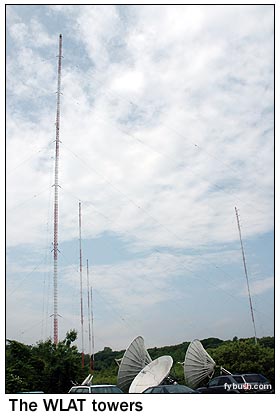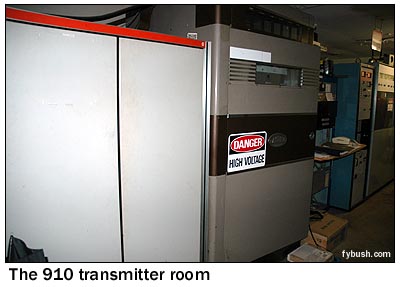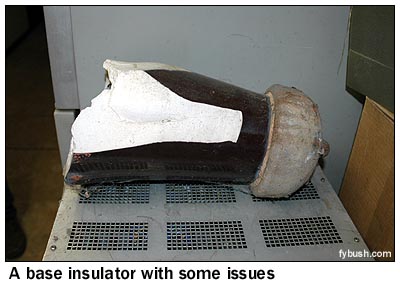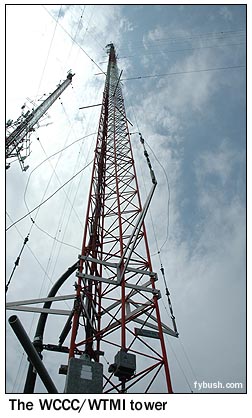
|
|

September 23, 2005
WLAT 910 and WCCC 106.9/WTMI 1290, Hartford CT
By SCOTT FYBUSH
 Our
big June sweep across New England wasn't limited to the northern
states. It also gave us a chance to get some nifty inside looks
at some sites in southern New England that we'd previously seen
only from the exterior, including a most enjoyable Friday in
the Hartford area.
Our
big June sweep across New England wasn't limited to the northern
states. It also gave us a chance to get some nifty inside looks
at some sites in southern New England that we'd previously seen
only from the exterior, including a most enjoyable Friday in
the Hartford area.
The day began up at the historic West Peak site in Meriden, one of the earliest FM transmitter sites in the nation and still home to most of the Hartford market's FMs. We'll show you those towers in more detail another week - alas, when we got up there, it was in pretty heavy fog and we weren't able to get very good exterior photos. (We'll fix that, sooner or later.)
The skies began to clear, thankfully, as we drove down from Meriden and headed west to Farmington, a leafy Hartford suburb. There on Birdseye Road is the station now known as WLAT (910 New Britain) - but this site has a history that long predates those calls.
The 910 facility went on the air in 1949 as WHAY, using this very site and a small transmitter building off to the edge of this image. In later years, the station was known as WRCH, then WRCQ, then WNEZ (all-news, starting in 1990, and later urban "910 Jamz."). Since 2001, when it swapped calls with the 1230 facility in Manchester, it's been Spanish as WLAT, and today it's one of the top Spanish-language radio voices in the market.
During the WRCH/WRCQ years, the station added an FM signal on 100.5, known as WRCH-FM, and it was then that a solid brick building was built along Birdseye Road to house the WRCH/WRCQ studios and transmitters. With the coming of duopoly and then clusters, the studios eventually moved out (WRCH-FM is now an Infinity station, operating from their studio complex a few miles away), but the space found a new use as the home of the Connecticut School of Broadcasting.
The WRCH-FM transmitter moved eventually, as well, finding a home on the tall towers of nearby Rattlesnake Hill - but an aux site remained in place here (check out the four bays on the tower off to the right) and is still used on occasion. WLAT uses the four in-line towers for its 5 kW night signal; it's 5 kW non-directional days.
The transmitter room has some nifty old gear in it - below, you see the Rockwell Collins that's a backup for WLAT, the vintage Raytheon (!) phasor cabinet, completely rebuilt more than a decade ago, the Nautel that now powers the AM and the vintage Collins that serves WRCH for backup use. And off beyond the Collins is a good reminder, as chief engineer John Ramsey tells us, of the importance of checking out your tower system: that's an insulator that shattered as it was being replaced. It turns out it was in rougher shape than anyone realized, and would likely have failed on its own if there hadn't been an insulator replacement project underway.

|

|
From the history at WLAT, we head for John's showplace site, the hilltop along US 44 in Avon that's home to his main employer, Marlin Broadcasting's WCCC-FM (106.9 Hartford) and WTMI (1290 West Hartford).

 That's
the new transmitter building that went up here not long ago,
and John's got a little of everything in here - a Gates One for
WTMI's analog signal, another Gates for WTMI's aux, a Harris
for WCCC-FM's aux and a newer Harris for WCCC-FM's analog and
digital main.
That's
the new transmitter building that went up here not long ago,
and John's got a little of everything in here - a Gates One for
WTMI's analog signal, another Gates for WTMI's aux, a Harris
for WCCC-FM's aux and a newer Harris for WCCC-FM's analog and
digital main.
We'll come back inside for a moment - but we've got to take a look outside, too, where the old WCCC-FM tower got a companion a few years back. Both towers are about 345 feet tall, and both are skirted.
The skirts are there for two reasons - first, to provide detuning so the towers don't disturb the pattern of nearby blowtorch WTIC (1080), just a couple of miles to the south, and second, because this has also been an AM site for a few years now. WTMI is the former WCCC(AM), and it lost its original West Hartford site and moved here a while back. It now runs 490 watts by day from one of these towers, with the other detuned on 1290 as well to avoid disturbing the 1290 signal.
WCCC, of course, is a legendary rock station in Hartford, and WTMI is about as far opposite as you can get. After years of simulcasting with the FM, Marlin flipped 1290 to classical in 2002, picking up the calls that had been on its Miami FM classical station (which was sold) and giving the beethoven.com classical webcast (which had been an outgrowth of Miami's WTMI-FM) a broadcast home in the market.
WTMI was one of the first stations in New England to add IBOC digital service, and you know what? It sounds awfully nice in digital, and the signal, while limited, does reach the affluent suburbs where the station would be most likely to find a loyal audience once the radios are available. (Even on the analog AM signal, WTMI has a small but loyal audience.)
With its commanding position astride a major commuter route into Hartford, this site is also very popular with wireless carriers and two-way users; you can see some of their antennas on the tower at left.
And after a most comprehensive tour with John, we're off to the south. Over the next two installments of Site of the Week, we'll take you inside WTIC's magnificent transmitter plant. Stay tuned!
JUST RELEASED - it's your very first chance to order the 2006 Tower Site Calendar! Click here for ordering information!
- Previous Site of the Week: WAMG/WBIX (night), Ashland MA
- Next Week: WTIC, Avon CT (part I)
- Site of the Week INDEX!
- How can you help support Site of the Week? Click here!
- Submit your suggestions for a future Site of the Week!
